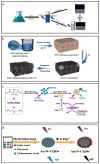Recent Advancements in Metal and Non-Metal Mixed-Doped Carbon Quantum Dots: Synthesis and Emerging Potential Applications
- PMID: 37630922
- PMCID: PMC10459133
- DOI: 10.3390/nano13162336
Recent Advancements in Metal and Non-Metal Mixed-Doped Carbon Quantum Dots: Synthesis and Emerging Potential Applications
Abstract
In nanotechnology, the synthesis of carbon quantum dots (CQDs) by mixed doping with metals and non-metals has emerged as an appealing path of investigation. This review offers comprehensive insights into the synthesis, properties, and emerging applications of mixed-doped CQDs, underlining their potential for revolutionary advancements in chemical sensing, biosensing, bioimaging, and, thereby, contributing to advancements in diagnostics, therapeutics, and the under standing of complex biological processes. This synergistic combination enhances their sensitivity and selectivity towards specific chemical analytes. The resulting CQDs exhibit remarkable fluorescence properties that can be involved in precise chemical sensing applications. These metal-modified CQDs show their ability in the selective and sensitive detection from Hg to Fe and Mn ions. By influencing their exceptional fluorescence properties, they enable precise detection and monitoring of biomolecules, such as uric acid, cholesterol, and many antibiotics. Moreover, when it comes to bioimaging, these doped CQDs show unique behavior towards detecting cell lines. Their ability to emit light across a wide spectrum enables high-resolution imaging with minimal background noise. We uncover their potential in visualizing different cancer cell lines, offering valuable insights into cancer research and diagnostics. In conclusion, the synthesis of mixed-doped CQDs opens the way for revolutionary advancements in chemical sensing, biosensing, and bioimaging. As we investigate deeper into this field, we unlock new possibilities for diagnostics, therapeutics, and understanding complex biological processes.
Keywords: biosensing; chemical sensing; mixed-doped CQDs; synthesis techniques.
Conflict of interest statement
The authors declare no conflict of interest.
Figures












Similar articles
-
Innovative Cerium and Chromium Co-doped Carbon Quantum Dots: Synthesis, Smartphone-Compatible and Sensitive Fluorescence Approach for Detection of Vitamin B12.J Fluoresc. 2025 Feb 13. doi: 10.1007/s10895-025-04165-6. Online ahead of print. J Fluoresc. 2025. PMID: 39945988 Review.
-
Facile synthesis of N-doped carbon dots for direct/indirect detection of heavy metal ions and cell imaging.Environ Sci Pollut Res Int. 2021 Apr;28(16):19878-19889. doi: 10.1007/s11356-020-11880-z. Epub 2021 Jan 6. Environ Sci Pollut Res Int. 2021. PMID: 33410047
-
Carbon quantum dots in spectrofluorimetric analysis: A comprehensive review of synthesis, mechanisms and multifunctional applications.Talanta. 2025 Oct 1;293:128066. doi: 10.1016/j.talanta.2025.128066. Epub 2025 Apr 2. Talanta. 2025. PMID: 40194462 Review.
-
Carbon quantum dots in bioimaging and biomedicines.Front Bioeng Biotechnol. 2024 Jan 22;11:1333752. doi: 10.3389/fbioe.2023.1333752. eCollection 2023. Front Bioeng Biotechnol. 2024. PMID: 38318419 Free PMC article. Review.
-
Ultra-high quantum yield nitrogen-doped carbon quantum dots and their versatile application in fluorescence sensing, bioimaging and anti-counterfeiting.Spectrochim Acta A Mol Biomol Spectrosc. 2021 May 15;253:119583. doi: 10.1016/j.saa.2021.119583. Epub 2021 Feb 13. Spectrochim Acta A Mol Biomol Spectrosc. 2021. PMID: 33652271
Cited by
-
Carbon Quantum Dots: Properties, Preparation, and Applications.Molecules. 2024 Apr 26;29(9):2002. doi: 10.3390/molecules29092002. Molecules. 2024. PMID: 38731492 Free PMC article. Review.
-
Nanoparticle-Based Therapies for Cardiovascular Diseases: A Literature Review of Recent Advances and Clinical Potential.Cureus. 2024 Oct 31;16(10):e72808. doi: 10.7759/cureus.72808. eCollection 2024 Oct. Cureus. 2024. PMID: 39552990 Free PMC article. Review.
References
-
- Azam N., Najabat Ali M., Javaid Khan T. Carbon quantum dots for biomedical applications: Review and analysis. Front. Mater. 2021;8:700403. doi: 10.3389/fmats.2021.700403. - DOI
-
- Wang C., Bi L., Liu J., Huang B., Wang F., Zhang Y., Yao C., Pan G., Song M. Microalgae-derived carbon quantum dots mediated formation of metal sulfide nano-adsorbents with exceptional cadmium removal performance. J. Colloid Interface Sci. 2023;629:994–1002. doi: 10.1016/j.jcis.2022.08.188. - DOI - PubMed
Publication types
Grants and funding
LinkOut - more resources
Full Text Sources
Research Materials

